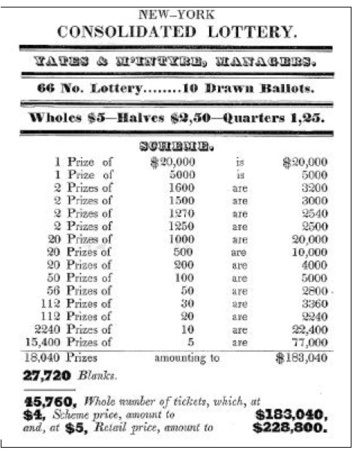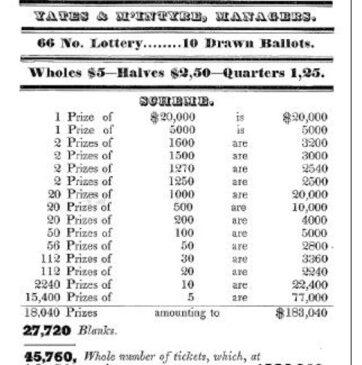The American Revolution was financed, in part, by lottery revenues. In 1776, the founding fathers in Congress established a lottery for the express purpose of funding the war for Independence. Several national universities, including Harvard, used lotteries as a means of capitalization; many early public works projects were similarly endowed. But the consequences of early lotteries were not all positive. Stories of numerous gambling addicts are recorded, including that of a certain employee of the now-defunct Bank of the United States who stole funds to purchase over $2000 of lottery tickets. After winning a grand total of $20, he was apprehended and imprisoned.
These anecdotes taken from the annals of American gambling history reveal a long and lasting presence for lotteries. As is the case today, early American lotteries were the domain of state legislatures. In addition, permission to run lotteries was often granted to individual townships and institutions. The logistics and operations, however, were generally conducted by private management firms. The financial arrangements among municipalities, legislatures, managers, and vendors were the source of much controversy. In April of 1811, the Commonwealth of Pennsylvania authorized a lottery to raise $340,000 for the construction of the Union Canal. Of the estimated $6,600,000 collected by managers each year, only $30,000 ended up in the coffers of the Union Canal Company. The decentralized nature of early lotteries may have contributed to the prevalence of fraud and misconduct. During one February, 76 indictments were handed down by the Municipal Court of the City of Boston for violations of lottery laws.
It was during this early period that the mechanism of lotteries changed drastically. Prior to the change, officials would draw one ticket from the “number-wheel” and one ticket from the “prize-wheel.” The holder of the former ticket would win the prize (or lack thereof) listed on the latter. Each entry ticket was drawn, and the process often took several days. Later lotteries sold tickets with a sequence of numbers. Winning tickets were those having a sequence identical to the one drawn by the official. The “scheme” for a lottery of this type is presented in the graphic above.
As with any historical document, cognizance of temporal and political context is essential for a critical reading.

Source: Gordon, G.W. (1833). Lecture on lotteries before the Boston Young Men’s Society. Boston: Temperance Press, Ford & Damrell .
This public education project is funded, in part, by The Andrews Foundation and the National Center for Responsible Gaming. For more information contact the Massachusetts Council on Compulsive Gambling.




